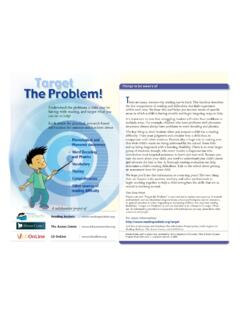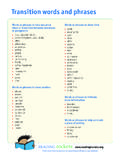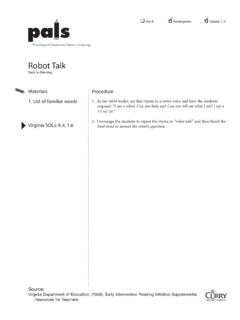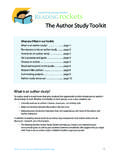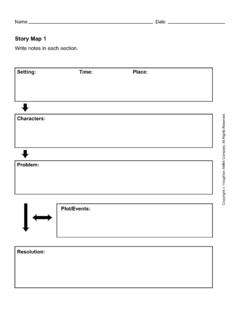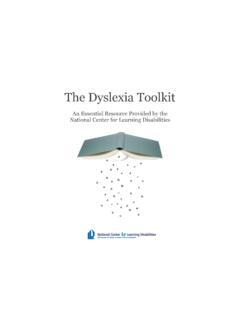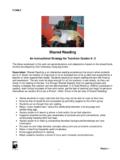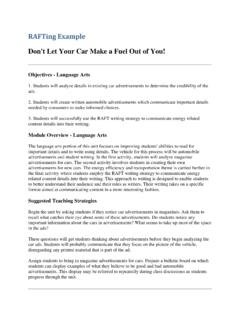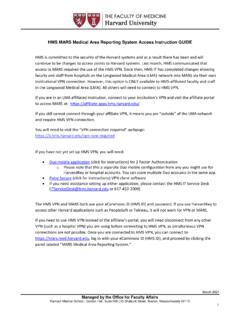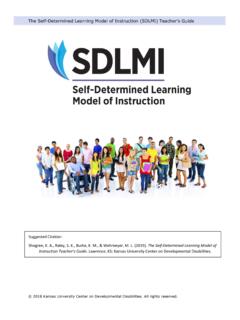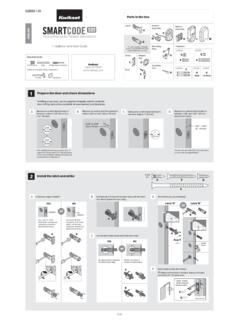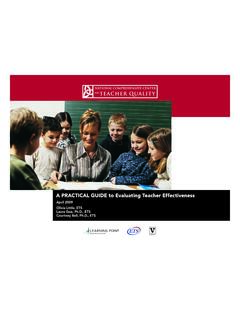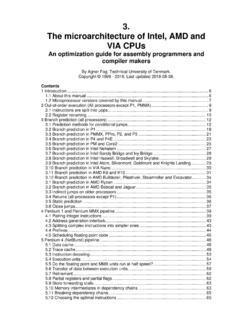Transcription of Using Instructional Routines to Differentiate Instruction
1 Using Instructional Routines . TO Differentiate Instruction . A guide for Teachers Using Instructional Routines . TO Differentiate Instruction . A guide for Teachers Marcia Kosanovich Network of Educators This publication was created by the Center on Instruction , which is operated by RMC Research Corporation in partnership with the Florida Center for Reading Research at Florida State University; Instructional Research Group; Lawrence Hall of Science at University of California, Berkeley; Texas Institute for Measurement, Evaluation, and Statistics at the University of Houston; and The Meadows Center for Preventing Educational Risk at The University of Texas at Austin. The author acknowledges the editorial and production support provided by Angela Penfold, C.
2 Ralph Adler, and Robert Kozman of RMC Research Corporation. The development of this document was supported by the Department of Education, Office of Elementary and Secondary Education and Office of Special Education Programs, under cooperative agreement S283B050034. However, these contents do not necessarily represent the policy of the Department of Education, and you should not assume endorsement by the Federal Government. Preferred citation: Kosanovich, M. (2012). Using Instructional Routines to Differentiate Instruction . A guide for teachers. Portsmouth, NH: RMC Research Corporation, Center on Instruction . Copyright 2012 by the Center on Instruction at RMC Research Corporation To download a copy of this document, visit CONTENTS. 3 PREFACE. 5 INTRODUCTION.
3 7 ABOUT THE Instructional Routines . 9 HOW TO READ THE Instructional Routines . 15 ALIGNMENT OF Instructional Routines TO. COMMON CORE STATE STANDARDS. 21 REFERENCES. 23 APPENDIX A: OVERVIEW OF EMPOWERING TEACHERS. WEBSITE AND MATERIALS. 25 APPENDIX B: HOW TO FIND STUDENT CENTER ACTIVITIES. TO USE WITH Instructional Routines . 1. PREFACE. Teachers, administrators, and policy-makers across the country need materials that address today's problems and initiatives. COI and its authors select topics and promote practices that have direct relevance to the urgent concerns and priorities of contemporary educators. For example, states seeking more rigorous college and career-ready standards as reflected in the Common Core State Standards need guidance to implement these standards, including specific strategies and interventions to support English language learners and students with special needs.
4 Schools implementing School Improvement Grants (SIGs). look for guidance on meeting the needs of diverse learners and Using data to inform Instructional decisions. Schools extending learning time need guidance on maximizing the use of Instructional time. This publication on the alignment of Instructional Routines to Common Core State Standards can inform the design, delivery, and use of evidence-based interventions with students, including those with disabilities, who struggle with mastering today's rigorous reading, literacy, and mathematics standards. It can also promote the continuous use of student data to Differentiate Instruction an essential practice for meeting each student's individual needs and raising the academic performance of a school. This guide will assist K 3 teachers Using the resources entitled Instructional Routines , which are located on an interactive website called Empowering Teachers, created by the Florida Center for Reading Research at Florida State University.
5 Instructional Routines helps teachers in creating differentiated Instruction in foundational reading skills. This guide to the Instructional Routines will also assist technical assistance providers and others who work with state education leaders to improve the reading achievement of elementary school children. The guide describes the Instructional Routines (IRs) and how teachers can use them to Differentiate reading Instruction in small groups. The Instructional Routines Instructional Routines and the offer K 3 teachers a range of activities in Empowering Teachers website a lesson plan format. They can be used can be found at flexibly because they provide a structure for assessment/ teaching specific foundational reading skills, 3. with explicit language and directions for teachers.
6 However, teachers can enrich the use of IRs by incorporating content based on students' Instructional needs related to the Common Core State Standards, such as specific words or texts. Technical assistance providers can use the Instructional Routines to: facilitate state-level discussions about classroom implementation resources that support improved reading Instruction , provide examples of differentiated reading Instruction at the elementary level, and offer a free resource that states can pass along to districts and schools. Although the IRs were prepared for use in Florida schools, they can work in any elementary school. They reflect scientific research on reading Instruction and can be integrated easily into any reading program that teaches the five essential components of reading (phonological awareness, phonics, fluency, vocabulary, and comprehension).
7 The entire suite of materials on the Empowering Teachers website aims to develop teachers' understanding of what differentiated Instruction is and why it is important. To this end, Appendix A of this guide summarizes all of the resources on the Empowering Teachers website. In addition to the Instructional Routines , the appendix describes: Essentials for Reading Success Elements of Effective Instruction How to Differentiate Instruction Questions to guide Instruction Planning Instruction and Tracking Progress Assessment Overview Resources In addition to the descriptions in Appendix A, this guide provides a table that displays the alignment of the Instructional Routines to the Common Core State Standards and a second appendix, Appendix B, which explains how to find Student Center Activities that are aligned to the Instructional Routines .
8 The author invites you to consider and implement the practices recommended in this guide , both for their value in meeting the goals of current initiatives such as SIG and Common Core State Standards and for the long-term strength of your educational programs. 4. INTRODUCTION. Differentiated Instruction means matching Instruction to meet the different needs of learners. To deliver the wide range of Instruction required to accommodate differing levels of learners in a classroom, teachers must use data-informed, small group Instruction designed specifically to meet students'. needs (Kosanovich, Ladinsky, Nelson, Torgesen, 2006). According to research on grouping students, implementing small group differentiated Instruction in the classroom leads to an increase in reading achievement (Lou, Abrami, Spence, Poulsen, Chambers, & d'Apollonia, 1996; Mathes & Fuchs, 1994; Moody, Vaughn, & Schumn, 1997).
9 Small group, teacher-led, differentiated Instruction usually occurs after whole group Instruction takes place. While the teacher leads small group Instruction , the other students can participate in reading centers (also referred to as work stations or literacy centers) special places organized in the classroom for students to work in small groups, pairs, or individually. In reading centers, students practice, demonstrate, and extend literacy learning independently of the teacher. Differentiated, teacher-led, small group Instruction requires the teacher to form small, flexible groups based on student data and observations. He or she organizes the classroom schedule in terms of the teaching time (number of days per week and number of minutes per day) for each small group.
10 The teacher determines each group's appropriate lesson structure or lesson plan based on students' Instructional needs. For instance, in a first grade classroom, one group of four students could work on segmenting and blending three phoneme words, while another group of five students learns and practices high frequency words and reads decodable text, while still a third group of six students learns about syllables and how to read multisyllabic words. The teacher uses data to form small, flexible groups that meet the specific needs of its students in terms of: the content and level of the lesson ( , area[s] of reading skill and level of Instruction ), the size of each group ( , 3 5 for struggling readers, 5 7 for other students, etc.), 5. the number of days per week each group participates in small group Instruction ( , daily, twice/week, 3 times/week), and the number of minutes per day ( , 10 minutes, 20 minutes, 30 minutes).
